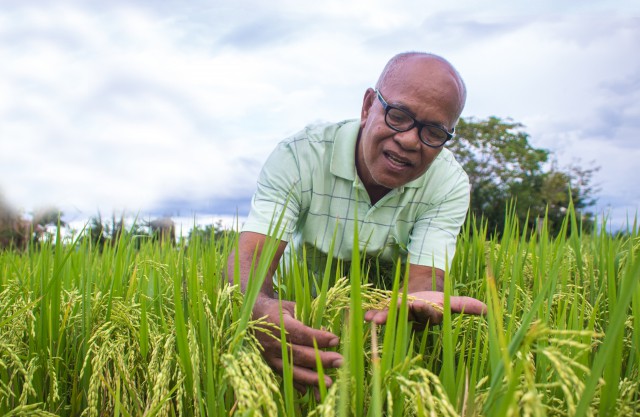Mestizo 1 (PSB Rc72H) lingers on Dumon Mabborang’s mind – irreplaceable and undeniably better than the others.
Mabborang, 63, of Buan West, Solana, Cagayan first planted it in 2003. A technician from DA convinced him to try the variety. Until now, he is still an avid fan of Mestizo 1.
Mestizo 1 still
Mabborang asserts the variety has better eating quality than most inbreds. “When cooked, it is soft, aromatic, and tastier,” he describes.
He recalls that some farmers who agreed to sell their produce before harvest changed their mind after tasting Mestizo 1. They say it is comparable to fancy rice owing to its aroma and softness.
The variety also stirred curiosity among consumers in their community.
“They asked me where they could buy the seeds and the milled version of the variety,” he says. Mestizo 1 can also be sold at a higher price than other hybrids. Its being not prone to leaf blight and hopperburn encouraged Mabborang to continue planting Mestizo 1.
Producing Mestizo with a twist
He followed the usual recommendations in planting hybrid rice – 20 kg seeds for a hectare at 1 seedling/hill. “A seedling is enough as it produces many tillers,” he says.
But for fertilizer management, he included bat manure to nourish his rice. He used 20 bags of it for a hectare, each costing P150 and weighing 20 kg.
Mabborang says that the bat manure made his rice resistant to pests and diseases. Grains are also heavier and with less unfilled grains. He would dissolve a bag of bat manure into 160L of water and soak it overnight.
Through a laboratory test, he found out that the manure has 6% nitrogen, 7% phosphorus, and 5% potassium.
Nitrogen or urea is responsible for faster growth development of rice; roots and flower develop through P; K makes the plant resistant to pests and diseases. The manure also serves as soil conditioner that improves drainage and texture.
Faithful to Mestizo 1
After following all the recommendations for planting Mestizo 1, Mabborang harvested an average of 8 t/ha. For him, the variety provides good yield and better income.
But to achieve higher yield and income, he advises farmers to be open to new ideas such as planting hybrid varieties. He used to buy seeds from the government but today, he himself produces them.
“Farming is a profession with constant challenges as the need for food continues to rise. So we need to try new technologies for us to keep up. One of them is hybrid,” Mabborang concludes.





